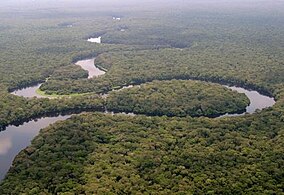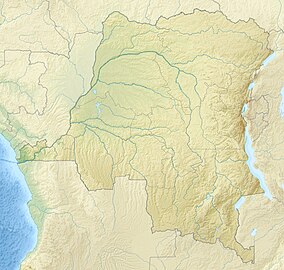Salonga National Park
| Salonga National Park Parc national de la Salonga | |
|---|---|
 View of a river in the Salonga National Park in 2005 | |
| Location | Democratic Republic of the Congo |
| Coordinates | 2°S 21°E / 2°S 21°E |
| Area | 36,000 km2 (14,000 sq mi) |
| Established | 1970 |
| Governing body | l'Institut Congolais pour la Conservation de la Nature (ICCN) |
| Type | Natural |
| Criteria | vii, ix |
| Designated | 1984 (8th session) |
| Reference no. | 280 |
| Region | Africa |
| Endangered | 1999–2021 |
Salonga National Park (
Geography
The park is in an area of rainforest about halfway between Kinshasa, the capital, and Kisangani. There are no roads and most of the park is accessible only by river.[1] Sections of the national park are almost completely inaccessible and have never been systematically explored.[1] The southern region inhabited by the Iyaelima people is accessible via the Lokoro River, which flows through the center and northern parts of the park, and the Lula River in the south[citation needed]. The Salonga River meanders in a generally northwest direction through the Salonga National Park to its confluence with the Busira River.[4]
History
The Salonga National Park was established as the Tshuapa National Park in 1956, and gained its present boundaries with a 1970 presidential decree by President Mobutu Sese Seko[citation needed]. It was registered as a UNESCO World Heritage Site in 1984.[5] Due to the civil war in the eastern half of the country, it was added to the List of World Heritage in Danger in 1999.[1]
The park is co-managed by the Institut Congolais pour la Conservation de la Nature and the World Wide Fund for Nature since 2015. Extensive consultation is ongoing,[6] with the two main populations living within the park; the Iyaelima, the last remaining residents of the park [5] and the Kitawalistes, a religious sect who installed them-self in the park just after its creation. An intense collaboration exists between the park guards and the Iyaelima, as Iyaelima villages are used as guard posts. It is known that bonobo densities are highest around Iyaelima villages which shows that they cause no threat to the park's emblematic species.[7]
Ecology
Located in the center of the
Many large mammals are found within the park at relatively high densities, including
Other than bonobo, park is home to several species primates such as Dryas monkey, Thollon's red colobus, Allen's swamp monkey, golden-bellied mangabey, red-tailed monkey, Potto, dwarf bushbaby.[11]
Other mammals in the park include the
There are many bird species present within the park, including the
56 fish species have been identified in the park, including the catfishes Clarias buthupogon and Synodontis nigriventris.[13] African
References
- ^ a b c d e f "Salonga National Park". UNESCO World Heritage Centre. United Nations Educational, Scientific, and Cultural Organization. Retrieved 13 June 2021.
- ^ Centre, UNESCO World Heritage. "World Heritage Committee Adds Four Sites to the List of World Heritage in Danger". UNESCO World Heritage Centre. Retrieved 2022-03-24.
- ^ "Request Rejected".
- ^ "Relation: Salonga (380844)", OpenStreetMap, retrieved 2021-03-21
- ^ a b Hopson, Mark (2011). "The Wilderness Myth: How the Failure of the American National Park Model Threatens the Survival of the Iyaelima Tribe and the Bonobo Chimpanzee". Earth Jurisprudence and Environmental Justice Journal. 1 (1).
- ^ CERDI-BAS (2016), Etude Stratégique des populations résidentes dans le parc national de la Salonga
- ISBN 978-0-387-74785-9.
- ^ S2CID 17600509.
- ^ S2CID 37674167.
- ^ a b Falk, John (2008). "Why the Bonobos Need a Radio and Other (Unlikely) Lessons From Deepest Congo". National Geographic. Archived from the original on 2012-04-03.
- ^ a b c "Salonga National Park". World Heritage Datasheet. Retrieved 20 December 2023.
- S2CID 84628639.
- ISSN 0030-6053.
Sources
- Furuichi, Takeshi; Thompson, Jo Myers (2008). The bonobos: behavior, ecology, and conservation. Springer. ISBN 978-0-387-74785-9.
- INCEF - Conservation and Health in Salonga
- Wildlife Conservation Society
- UNESCO Salonga National Park Site
- WCMC Site Data Sheet


